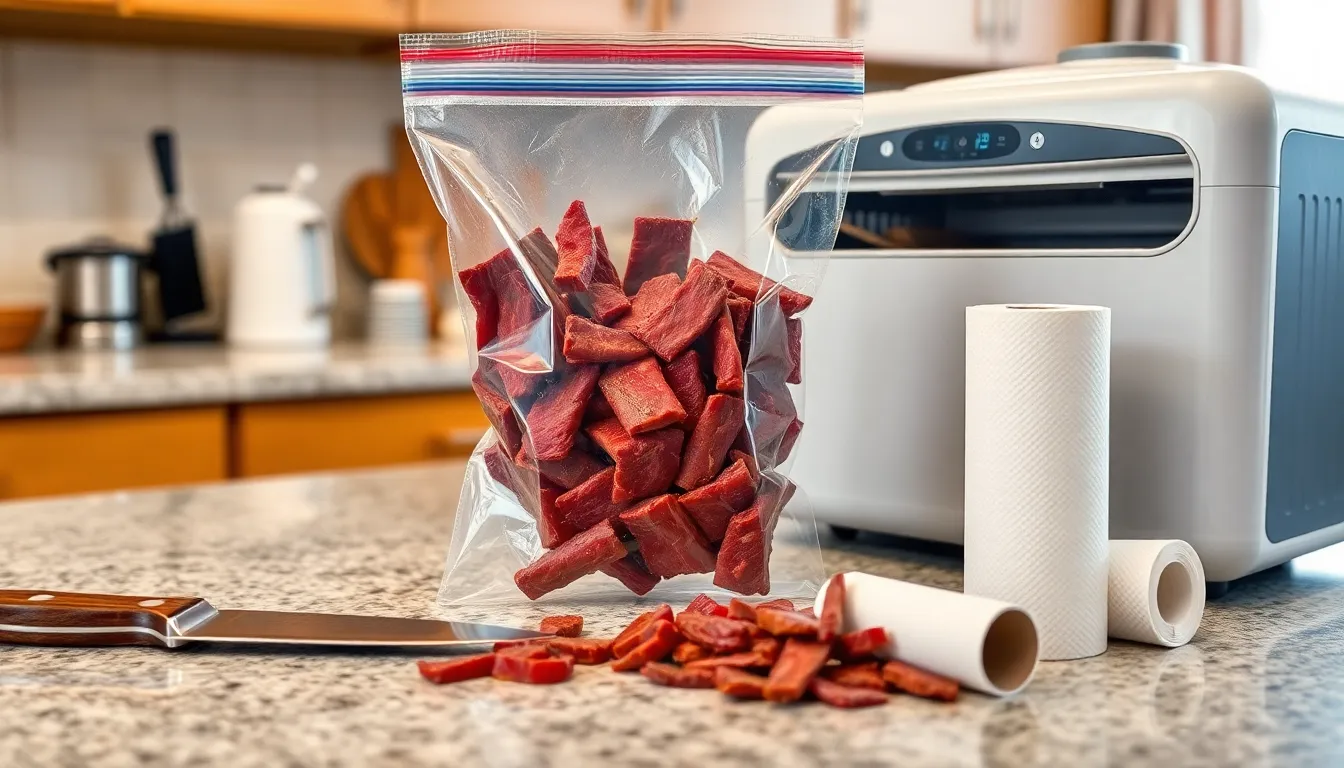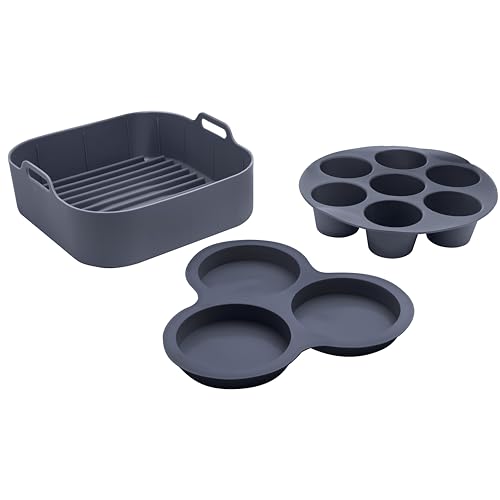Nothing beats the satisfaction of crafting your own beef jerky with a perfectly balanced marinade. We’ve spent countless hours perfecting this recipe that transforms ordinary beef into an extraordinary snack that’ll have you ditching store-bought jerky forever.
Our homemade beef jerky marinade combines the perfect blend of salty soy sauce, tangy Worcestershire, and aromatic spices that penetrate deep into the meat. The secret lies in the balance – we’ve eliminated the guesswork so you can achieve that professional jerky flavor every single time.
Whether you’re preparing for camping trips, looking for a protein-packed snack, or wanting to impress friends with your culinary skills, this marinade recipe delivers consistent results. We’ll show you exactly how to create jerky that’s tender, flavorful, and completely addictive – all from the comfort of your own kitchen.
Ingredients
Our beef jerky marinade recipe features carefully selected ingredients that create the perfect balance of savory, sweet, and umami flavors. We’ve organized these ingredients into essential components and optional additions to help you customize your jerky experience.
For the Basic Marinade
- 1/2 cup soy sauce (low sodium preferred)
- 1/4 cup Worcestershire sauce
- 2 tablespoons brown sugar
- 1 tablespoon apple cider vinegar
- 2 teaspoons garlic powder
- 2 teaspoons onion powder
- 1 teaspoon black pepper (freshly ground)
- 1 teaspoon smoked paprika
- 1/2 teaspoon salt
- 1/4 teaspoon cayenne pepper
Optional Flavor Add-ins
- 1 tablespoon liquid smoke (for extra smokiness)
- 1 teaspoon ground ginger (for Asian-inspired flavor)
- 1 tablespoon honey (for additional sweetness)
- 1 teaspoon red pepper flakes (for heat lovers)
- 2 tablespoons teriyaki sauce (for a sweeter profile)
- 1 teaspoon dried herbs (rosemary, thyme, or oregano)
- 1 tablespoon hot sauce (your favorite variety)
- 1 teaspoon sesame oil (for Asian fusion taste)
Equipment Needed

Making homemade beef jerky requires exact tools to achieve professional results. We’ve compiled the essential equipment list to ensure your jerky turns out perfectly every time.
Sharp Knife
A quality sharp knife proves indispensable for slicing meat into uniform strips. We recommend maintaining your blade’s sharpness since clean cuts prevent ragged edges that can affect drying consistency. Thin slicing becomes significantly easier when you partially freeze your beef for 1-2 hours before cutting.
Large Zip-Top Bag or Mixing Bowl
Either option works well for marinating your beef strips. Zip-top bags offer better distribution of marinade and take up less refrigerator space. Large mixing bowls provide easier access for stirring and coating but require more storage room during the marinating process.
Food Dehydrator
A food dehydrator delivers the most consistent results for drying jerky. These appliances maintain steady temperatures around 160°F and provide even airflow across all trays. Oven drying serves as an alternative method though it requires more attention and monitoring throughout the process.
Paper Towels
Patting meat strips dry before dehydrating speeds up the drying process and improves final texture. Excess marinade on the surface can extend drying time and create uneven results across your batch.
Freezer Space
Your freezer helps firm the meat for easier slicing and provides storage for finished jerky. Partially frozen beef cuts more cleanly and reduces waste from uneven pieces that might not dry properly.
Each piece of equipment serves a exact purpose in creating perfectly textured jerky. Quality tools make the difference between amateur and professional results in your homemade jerky production.
Instructions

Creating exceptional beef jerky requires precise marinade preparation and proper marinating technique. Follow these detailed steps to transform lean beef into flavorful jerky that rivals any store-bought option.
Preparing the Marinade
We start by combining our essential liquid ingredients in a large mixing bowl. Pour 1/2 cup soy sauce and 1/4 cup Worcestershire sauce together. Add 3 tablespoons brown sugar and whisk until completely dissolved. The sugar creates the perfect balance between salty and sweet flavors.
Next we incorporate the aromatic spices that define our jerky’s character. Mix in 1 tablespoon apple cider vinegar along with 2 teaspoons garlic powder and 1 teaspoon onion powder. Add 1 teaspoon smoked paprika for that authentic smoky depth. Season with 1/2 teaspoon salt and 1/2 teaspoon black pepper.
For those who prefer additional heat we recommend adding 1/4 teaspoon cayenne pepper at this stage. Liquid smoke enthusiasts should include 1/2 teaspoon of hickory or mesquite liquid smoke for enhanced smoky flavor without actual smoking. Whisk all ingredients thoroughly until the mixture appears uniform and no sugar granules remain visible.
Marinating the Beef
Begin by selecting lean beef cuts such as eye of round or top round roast. We recommend partially freezing the beef for approximately 1 hour before slicing. This technique makes cutting uniform strips significantly easier and ensures consistent texture throughout the jerky.
Remove the beef from the freezer and trim away any visible fat using a sharp knife. Fat prevents proper preservation and can cause spoilage during the drying process. Slice the beef into strips measuring 1/8 to 1/4 inch thick. Cut against the grain for tender jerky or with the grain for a chewier texture.
Place the beef strips in a large zip-top bag or non-reactive container. Pour the prepared marinade over the meat ensuring all pieces are completely submerged. Seal the bag tightly and massage gently to distribute the marinade evenly. Refrigerate for a minimum of 12 hours with 24 hours yielding optimal flavor penetration.
During the marinating process we turn the bag every 6 to 8 hours. This ensures even absorption and prevents any strips from remaining uncoated. After marinating remove the beef from the container and pat each strip dry with paper towels. Excess liquid must be removed before proceeding to the drying phase for proper jerky formation.
Directions for Making Beef Jerky

After your beef has absorbed all those incredible flavors from our marinade, it’s time to transform those strips into perfectly dried jerky. We’ll walk you through three proven methods that deliver professional-quality results every time.
Dehydrator Method
Remove the marinated beef strips from the refrigerator and pat them dry with paper towels to eliminate excess moisture. Arrange the meat pieces in a single layer on your dehydrator trays, ensuring no pieces overlap or touch each other. Set your dehydrator temperature to 145°F (62°C) for optimal drying conditions.
Start the drying process and let it run for 4 to 6 hours, checking progress every 2 hours. Occasionally blot any fat droplets that appear on the surface using clean paper towels. Test for doneness by removing a cooled piece and bending it gently – properly dried jerky should crack but not break completely in half.
This method provides the most consistent results because dehydrators maintain steady temperature and airflow without actually cooking the meat. We recommend this approach for beginners since it requires minimal monitoring and produces evenly dried jerky every time.
Oven Method
Preheat your oven to 275°F (135°C) while preparing your jerky strips for drying. Line a baking sheet with parchment paper and arrange the marinated beef strips in a single layer, making sure they don’t overlap. Place the baking sheet on the middle rack of your preheated oven.
Dry the strips for approximately 10 minutes if you’ve already dehydrated them partially, or extend the time for strips going directly into the oven. Keep your oven door slightly ajar using a wooden spoon to allow moisture to escape during the drying process.
Monitor the jerky closely since ovens can create hot spots that might overcook certain areas. This method works well when you need jerky quickly or don’t own a dehydrator, though it requires more attention than other techniques.
Air Fryer Method
Place your marinated beef strips in the air fryer basket without any overlap, working in batches if necessary to avoid crowding. Set the air fryer temperature to 145°F to 160°F, depending on your model’s lowest available setting.
Dry the strips for 4 to 6 hours, checking every hour to ensure even drying and prevent overcooking. Rotate the strips halfway through the process to guarantee uniform results throughout each piece.
Air fryers offer excellent convenience when dehydrators aren’t available, but they require careful monitoring since some models run hotter than their displayed temperatures. We suggest testing a small batch first to determine your air fryer’s optimal time and temperature settings for jerky making.
Tips for Perfect Beef Jerky

Creating exceptional beef jerky requires attention to three critical elements that separate amateur attempts from professional results. We’ll guide you through selecting the ideal meat cut, mastering slicing techniques, and timing your marinade for optimal flavor penetration.
Choosing the Right Cut of Meat
We recommend selecting lean cuts with minimal fat content since fat spoils quickly and compromises jerky preservation. Top round stands as our preferred choice due to its exceptional leanness and affordability while responding beautifully to marinades for enhanced tenderness.
Bottom round offers similar benefits with slightly more marbling that adds flavor without excessive fat content. Eye of round provides the leanest option available and works perfectly when you want maximum protein concentration. Flank steak delivers outstanding flavor but requires careful fat trimming before preparation.
Round steak emerges as the most popular choice among jerky enthusiasts because it combines affordability with consistent results. We’ve found that these lean cuts absorb our marinade flavors deeply while maintaining the proper texture for long-term storage.
Slicing Techniques
We slice our beef strips between 1/8 to 1/4 inch thick for optimal drying and texture results. Partially freezing the meat for 1-2 hours before slicing makes achieving uniform thickness significantly easier and more precise.
Cutting against the grain produces tender jerky that breaks apart easily between your teeth. We recommend this technique for most applications since it creates a more pleasant eating experience. Slicing with the grain yields chewier jerky that some prefer for its satisfying texture and longer chewing time.
Sharp knife technique proves essential for clean cuts that dry evenly throughout the dehydration process. We maintain consistent pressure and use long smooth strokes rather than sawing motions to prevent meat fiber damage.
Marinating Time Guidelines
We marinate our beef strips for a minimum of 4 hours though overnight marination produces significantly better results. The optimal marinating window spans 8 to 24 hours allowing flavors to penetrate deeply throughout each strip.
Extended marinating beyond 4 hours enhances both tenderness and taste development creating more complex flavor profiles. We keep all marinating meat refrigerated at 40°F or below to prevent bacterial growth and maintain food safety standards.
Longer marination periods up to 24 hours yield the best flavor penetration without compromising meat texture. We’ve tested various timeframes and consistently achieve superior results when allowing full overnight marination for maximum flavor absorption.
Storage Instructions

After successfully drying our beef jerky using any of the methods we discussed, proper storage becomes the final crucial step in preserving our homemade creation. We must allow the jerky to cool completely before placing it in any storage container to prevent moisture buildup that could lead to spoilage.
Immediate Storage Steps
We recommend patting each jerky strip dry with clean paper towels to remove any remaining surface moisture before storage. This extra step ensures our jerky maintains its ideal texture and prevents stickiness that can develop when excess moisture remains on the surface.
For short-term storage, we place our completely cooled jerky in airtight containers or sealed plastic bags. Glass jars with tight-fitting lids work exceptionally well for maintaining freshness while allowing us to monitor the jerky’s condition.
Storage Duration and Conditions
| Storage Method | Location | Duration |
|---|---|---|
| Airtight container | Cool, dry pantry | Up to 1 month |
| Sealed plastic bag | Refrigerator | 2-3 months |
| Vacuum sealed | Room temperature | Up to 1 year |
| Vacuum sealed with oxygen absorbers | Room temperature | Up to 1 year |
We store our jerky in cool, dry places away from direct sunlight and heat sources. Room temperature storage works perfectly for properly dried jerky when kept in airtight conditions.
Extended Storage Options
For longer preservation, we refrigerate our jerky to extend its shelf life to approximately two to three months. The refrigerator’s consistent temperature helps maintain the jerky’s quality and prevents any potential bacterial growth.
Vacuum sealing represents our most effective long-term storage solution. We can preserve vacuum-sealed jerky for up to one year when stored at room temperature. Adding oxygen absorbers to vacuum-sealed packages provides additional protection against oxidation and further extends storage life.
We always label our storage containers with the preparation date to track freshness and ensure we consume our jerky within the recommended timeframes. This practice helps us maintain food safety standards while enjoying our homemade beef jerky at its peak quality.
Flavor Variations

Our base marinade serves as the perfect foundation for countless flavor combinations. These three variations showcase how simple ingredient adjustments can transform your jerky into distinctly different taste experiences.
Spicy Jalapeño Marinade
We combine fresh jalapeños or habanero peppers with our base marinade to create this fiery variation. The heat comes from 5 habaneros or jalapeños minced finely and mixed with 2 cups low sodium soy sauce, 2 cups brown sugar, and 1/2 cup Worcestershire sauce. Balsamic vinegar adds depth at 2/3 cup while citrus juices from orange or grapefruit brighten the overall flavor profile.
Our spicy marinade achieves perfect balance through sweetness countering the heat. Crushed red pepper flakes amplify the jalapeño burn while garlic and onion powders provide savory undertones. Some recipes incorporate Dr. Pepper soda for an unexpected spicy-sweet twist that pairs beautifully with the pepper heat.
Liquid smoke rounds out this variation by adding complexity that complements rather than competes with the spice level. We recommend starting with fewer peppers for your first batch and adjusting heat levels based on your preference.
Sweet Teriyaki Marinade
This Asian-inspired variation emphasizes soy sauce paired with generous amounts of brown sugar or honey. We build the marinade foundation with soy sauce and garlic while adding fresh ginger for authentic teriyaki character. Sesame oil or toasted sesame seeds contribute nutty notes that define this style.
Our sweet teriyaki combination creates jerky with pronounced umami flavors balanced by natural sweetness. Hot honey garlic variations incorporate hot sauce or barbecue rub to add complexity without overwhelming the teriyaki base. Brown sugar caramelizes during the drying process to create appealing color and concentrated sweetness.
The key lies in achieving proper sweet-to-salty ratios that highlight the beef while creating that distinctive teriyaki glaze effect. We find that honey produces slightly different results than brown sugar, offering more floral notes in the finished jerky.
Smoky BBQ Marinade
Liquid smoke or smoked paprika forms the backbone of our BBQ variation by delivering authentic grilled flavors without firing up the smoker. We combine soy sauce with minced garlic, hot sauce, and BBQ rub seasoning to create the smoky foundation. Brown sugar and honey provide sweetness that balances the smoky intensity.
Black garlic sauce adds sophisticated depth that separates our BBQ marinade from basic versions. Sesame oil contributes richness while classic barbecue spices like paprika and black pepper enhance the overall flavor complexity. Hot sauce amplifies the savory profile without making the jerky overly spicy.
Our smoky BBQ marinade produces jerky with rich, complex flavors reminiscent of perfectly smoked brisket. The combination requires 12 to 24 hours of marinating time to fully develop the layered flavors that make this variation so satisfying.
Conclusion
Creating exceptional beef jerky at home isn’t just about following a recipe—it’s about mastering the art of balance and patience. We’ve equipped you with everything needed to transform simple ingredients into professional-quality jerky that’ll have everyone asking for your secret.
The beauty of our marinade recipe lies in its versatility. Whether you’re craving the classic blend or want to experiment with our spicy jalapeño or smoky BBQ variations there’s a flavor profile that’ll satisfy every palate.
Remember that great jerky comes from attention to detail: proper meat selection consistent slicing technique adequate marinating time and careful drying. With these fundamentals mastered you’ll consistently produce jerky that rivals any store-bought option.
Now it’s time to fire up that dehydrator and start creating your own batch of perfectly seasoned homemade beef jerky.
Frequently Asked Questions
What cut of beef is best for making homemade jerky?
The best cuts for beef jerky are lean cuts like top round, bottom round, eye of round, flank steak, and round steak. These cuts have minimal fat content, which is essential for proper preservation and texture. Lean meat ensures your jerky will last longer and won’t spoil quickly, while providing the ideal chewy consistency that makes great jerky.
How long should I marinate beef for jerky?
Marinate beef for a minimum of 4 hours, but optimal results are achieved between 8 to 24 hours. The longer marination time allows for better flavor penetration throughout the meat. For best results, massage the marinade into the meat and turn the bag periodically to ensure even absorption of flavors.
What temperature should I use for drying beef jerky?
For dehydrator method, use 145°F (62°C) for 4-6 hours. For oven drying, preheat to 275°F (135°C) and monitor closely. The dehydrator method is recommended for beginners as it provides the most consistent results. Air fryer method is also possible but requires careful attention to prevent overcooking.
How do I slice beef for jerky properly?
Cut beef against the grain for maximum tenderness and aim for uniform thickness of about 1/4 inch. Partially freeze the meat for 1-2 hours before slicing to make cutting easier and more precise. Use a sharp knife and trim all visible fat, as fat can cause spoilage and prevent proper preservation.
How long does homemade beef jerky last?
Properly stored homemade beef jerky lasts 1-2 weeks in airtight containers at room temperature, 1-2 months in the refrigerator, and up to 6 months in the freezer. Vacuum sealing extends shelf life up to one year at room temperature. Always label containers with preparation dates and ensure jerky is completely cooled before storage.
What are the essential ingredients for beef jerky marinade?
The basic marinade includes soy sauce, Worcestershire sauce, brown sugar, apple cider vinegar, garlic powder, onion powder, black pepper, smoked paprika, salt, and cayenne pepper. These ingredients create the perfect balance of salty, sweet, and savory flavors that make professional-quality jerky at home.
Can I make beef jerky without a dehydrator?
Yes, you can make beef jerky using an oven or air fryer. The oven method involves drying at 275°F (135°C) with the door slightly open for air circulation. Air fryers work well for small batches. However, dehydrators provide the most consistent results and are recommended for beginners.
How do I know when beef jerky is done?
Properly dried beef jerky should bend without breaking and feel dry to the touch without being brittle. It should crack slightly when bent but not snap in half. The jerky should have no moisture when pressed and should be evenly dried throughout all pieces.




































